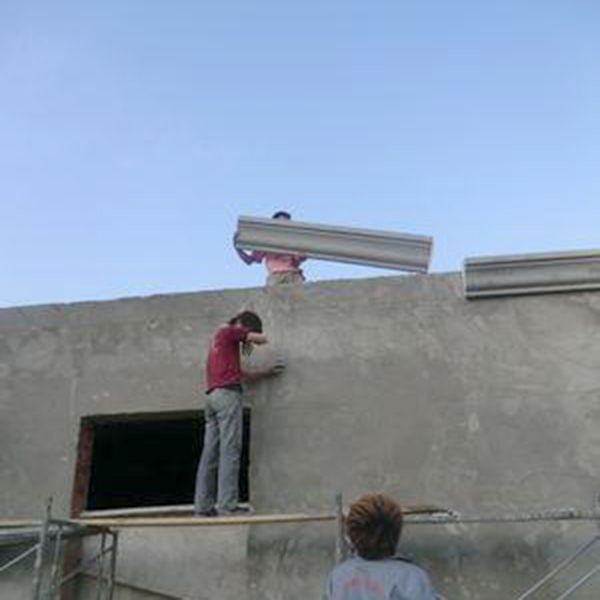
 2017-9-28
2017-9-28
1. Preparation basis
1) GB/T10801.1-2002 Molded polystyrene foam for heat insulation
2) DBJ-63-2002 polymer mortar for external wall insulation technical specification
3) DBJ/T01-38-2002 External insulation construction technical regulations
4) DBJ01-97-2005 Construction quality acceptance regulations for energy saving and insulation engineering of residential buildings
Ii. Preparation of instructions
Installation workers must perform the first installation under the guidance of the company's on-site engineers.
Third, construction tools
Saw blade, hand saw, tape measure, square, trowel, wallpaper knife, scissors, wire board, 2m ruler, broom, gray knife, electric mixer, wire brush, ink fountain, sandpaper, etc.
4. Check before construction
1. The environmental humidity of the construction site and the surface temperature of the base wall shall not be lower than 5 ° C within 24 hours after construction, the wind shall not be greater than 5, and the dry water rate of the base wall shall be less than 10%.
2, check and remove the basic wall floating ash stains, release agents, empty drums, protrusions and weathering and other foreign bodies that affect the bond strength.
3, flatness, perpendicularity requirements: the maximum deviation of the meter with the horizontal line should be less than 4mm.
5. Construction technology
1, to be installed wall, window door openings and other construction procedures have been completed and accepted.
2. According to the construction drawings, pop up the positioning line (middle line or side line) at the part where the EPS component is to be installed.
3. Cut EPS components according to the installation size of the drawings. EPS components are standard sizes, and the joint width should be considered when cutting.
4. When the EPS component is pasted, the mesh cloth should be turned over. If there are special circumstances, it can be directly pasted without turning over the bag. The adhesive of polystyrene EPS component is pasted with the bonding mortar CBMA65 of SINomaterials Institute, and the thin layer full bonding method is adopted. The EPS component is strongly squeezed to make the mortar overflow from the periphery, and the adhesive joint width is not more than 3mm. The adhesive joint should be hooked with the adhesive, the ash joint should be full, and the surface of the EPS member should be kept clean.
5. For large EPS components, support is required for temporary fixing during installation.
6, when installing, if it is necessary to splice, the assembly size and Angle should be measured in advance, and pre-assembly should be carried out in the flat place, and the gap is not more than 3mm. Using CBMA25 bonding mortar of "China Materials Institute" as splicing bonding material, the consistency of the mortar can be larger, and the thin layer full bonding method is adopted. When splicing, it is required to slightly and evenly squeeze the hammer to make the ash joint meet the requirements.
7. After splicing the ash joint, the ash knife should be used to flatten it, so that the EPS component becomes one. After drying, if there is excess bonding mortar at the joint of EPS member, it can be polished with sandpaper.
8. After drying, the splicing parts of EPS components are treated with EPS component anti-cracking special adhesive developed by China General Research Institute of Building Materials Science. For treatment, see the instructions for use of special anti-cracking adhesive.
9. Joint treatment: When the joint width is not more than 3mm, the next day after installation, the joint will be polished with sandpaper, and the CBMA25 covering mortar will be used to paste 100mm wide glass fiber mesh cloth with a thickness of less than 2mm; When the joint is wider than 3mm, the joint should be filled with thin polystyrene sheets, and then reinforced with 100mm wide glass fiber mesh cloth pasted with CBMA25 finishing mortar. After drying, if there is excess mortar left in the stitching, the treatment method is the same as above.
10. Pay attention to the protection of finished EPS components after construction, and prohibit pedaling and heavy impact. If there is damage, the entire EPS component should be removed and rebuilt.
Six, precautions
1, the construction of the ambient temperature should not be greater than 38 ° C, not less than 5 ° C, below this temperature bonding mortar must use antifreeze formula. The wind is no more than force 5.
2, before the installation and cutting of EPS components, the wall does not need to be sprayed with water to wet, dust, stains and other debris affecting the bond strength should be cleaned up.
3. When assembling, the assembly seam should be left in the middle of the entire EPS component as far as possible.
4. When bonding EPS components, mortar water is added according to the recommended water amount. However, the amount of water added to the mortar during splicing should be 1 ~ 2% more than the recommended amount.
5, just bonded EPS components should pay attention to maintenance, to prevent rain erosion, artificial damage, etc.
Vii. Acceptance
The completion acceptance shall be carried out according to DBJ01-97-2005 "Construction Quality Acceptance Regulations for Energy Saving and Thermal insulation Engineering of Residential Buildings" and other relevant standards.







